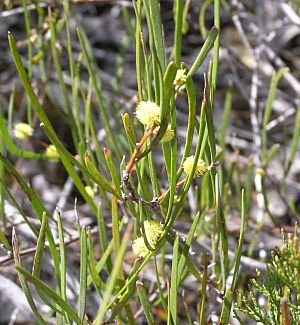Granite wattle facts for kids
The granite wattle (Acacia granitica) is a cool shrub from the Fabaceae family, also known as the pea family. This plant is special because it only grows in Australia, mainly in parts of New South Wales and southern Queensland. It's super tough and can handle wet ground, frost, and even snow!
Quick facts for kids Granite wattle |
|
|---|---|
 |
|
| Acacia granitica in Girraween National Park | |
| Scientific classification | |
| Genus: |
Acacia
|
| Species: |
granitica
|
 |
|
| Occurrence data from AVH | |
Contents
What the Granite Wattle Looks Like
The Acacia granitica is usually a spreading or upright shrub. It grows about 1 to 1.5 meters (3 to 5 feet) tall and wide. Sometimes, in good conditions, it can reach up to 3 meters (10 feet) tall.
Its branches grow out from the ground. They have a rough bark with lines on them. The smaller branches are smooth and round.
Leaves and Flowers
The leaves of the granite wattle are called phyllodes. They are long and narrow, like thin straps. They can be 10 to 25 centimeters (4 to 10 inches) long and very thin, only 0.5 to 3 millimeters (0.02 to 0.1 inches) wide. Each phyllode is smooth or has tiny silky hairs. They have several faint parallel veins, and sometimes one main vein stands out more. The phyllodes end in a stiff, pointed tip.
The flowers are pale yellow to bright yellow. They grow in small groups, about 3 to 10 millimeters (0.1 to 0.4 inches) long. These flower groups appear in pairs where the phyllodes join the stem. The flower stalks are short, about 0.5 to 3 millimeters (0.02 to 0.1 inches) long, and covered in fine hairs.
Seed Pods
After flowering, the plant produces seed pods. These pods are a dull mid-brown color. They are narrow and can be straight or slightly curved. They grow to be 3 to 9.5 centimeters (1 to 4 inches) long and 2 to 3 millimeters (0.08 to 0.1 inches) wide. The pods have fine lines running lengthwise and are firm but brittle when they are ready. They can be smooth or have a few fine hairs at the very end.
This wattle is very tough. It can handle snow, frost, and even very wet ground. It usually flowers from late July to early October.
How the Granite Wattle Got Its Name
The Acacia granitica was first officially described in 1921 by a scientist named Joseph Maiden. He published his description in a science journal.
Interestingly, this wattle was first given a different name in 1921. It was called Acacia doratoxylon var. ovata by Maiden and another scientist, Ernst Betche. They found a sample of the plant near Stanthorpe.
Later in 1921, Joseph Maiden decided to make it its own species. He named it Acacia granitica. He chose this name because the name Acacia ovata was already being used for a different plant. Maiden didn't say exactly why he picked "granitica," but he did write that the plant "apparently always on granite." This suggests he named it because it grows on granite rocks.
Where the Granite Wattle Grows
This special plant mostly grows in north-eastern New South Wales. You can find it near places like Bendemeer, Torrington, and Guyra. It likes to grow on granite outcrops, which are areas where granite rock sticks out of the ground. It prefers shallow, sandy soil there.
You can also find it on sandstone in eucalypt forests. Sometimes it grows in heathlands or near creeks. Its range extends from north of Grafton in New South Wales all the way up to Crows Nest in Queensland. As mentioned before, it's a hardy plant that can tolerate wet ground, frost, and snow.

